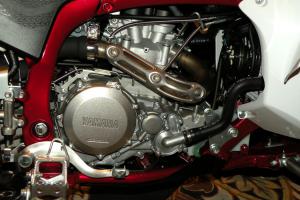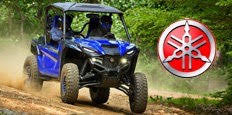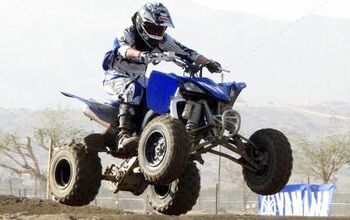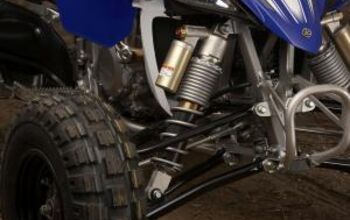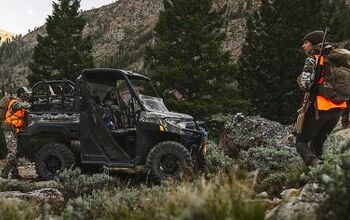2009 Yamaha YFZ450R Preview
Don’t be fooled by Yamaha’s new YFZ450R. Though it sounds basically the same as the venerable YFZ450 in name, this quad is an entirely different animal altogether. Yamaha didn’t just tweak the YFZ450 here and there and throw on the ‘R’. Instead the slate was wiped completely clean and a new machine was built from the ground up, including a new engine, new frame and new motocross-wide chassis.
When putting this quad together, Yamaha had to figure out who was going to buy it. According to the company’s research, 50% of its customers say racing technology was their main influence for purchasing the YFZ450. However, only 15% actually race the quads on motocross tracks. Ultimately, Yamaha decided it needed to build an affordable vehicle that would appeal to the average customer that wanted the latest racing technology but wasn’t going to race, as well as the hard-core customer that wanted a machine that could be easily modified in order to compete on the track. This was no small task, but Yamaha came up with some interesting solutions.
The wider footprint of the YFZ450R offers more stability when cornering.
First off, at 48.8 inches wide, the YFZ450R is three inches wider than the YFZ450. That is fully motocross legal, so you can ride on the track without having to add spacers or replace the front end or rear axle. What Yamaha didn’t do was equip it with 18-inch rear track tires. Because most YFZ450R owners don’t ride on the track, 18-inch tires don’t make as much sense. Instead, 20-inch rear tires are standard, which can be used on the track for the average rider, as well as in cross-country settings.
For those who plan on using the YFZ450R for on-track racing, ITP Holeshot tires mounted on beadlock T-9 wheels are available through GYTR (Genuine Yamaha Technology Racing).
Since you’re not going to appeal to anybody without a competitive engine, Yamaha built a brand new one for the YFZ450R. It shares the same bore and stroke as its predecessor, but everything else is new, including electronic fuel injection. Also, the cylinder head and cylinder were borrowed from the YZ450F dirt bike and it features new crankcases, new gear ratios and a new crankshaft. Yamaha says power has been increased from bottom to top. That’s a lofty claim, but we’ll find out for sure when we get a chance to ride it.
With a new 5-valve DOHC liquid cooled single cylinder 449cc engine in place, the average rider should have more than enough technology to be happy. For those that demand more performance, a slew of modifications are available through GYTR. A fully assembled CNC ported head, CNC machined cam set and high compression piston will be available for the YFZ450R’s November release. Also, a GYTR exhaust and air filter can be added, which offers a claimed 10% increase in horsepower at peak RPM and 20% at 9,500 RPM. A fuel mapping ECU is also an option, as are clutch components, including clutch basket, inner clutch hub, pressure plate and clutch cover.
Yamaha says the new engine case and crankshaft offer increased strength and durability, key for the rider who does a lot of modifications and is generally harder on the quad. Also new are the internal oil tank and passages. The original YFZ450 had an external tank. According to Yamaha, the internal design is simpler, more compact, helps centralize the mass and is easier to service.
As impressive as the new engine seems to be, perhaps the biggest change is with the frame. Yamaha decided not to use the steel frame of the YFZ450 and built a brand new cast aluminum main frame. Yamaha says it’s 15% lighter than steel and stronger because it has no welds.
The wide arc front suspension is all new.
New long-travel front shocks offer 9.8 inches of travel – 0.7 inches more than the YFZ450. Also, the front shocks are considerably longer and larger and have softer springs. The shocks have a Kashima coating on the body. This coating decreases shock temperature and friction, helping to improve shock life.
The new wide arc lower A-arms are 2.65 inches wider per side. The wide arc design, according to Yamaha, increases ground clearance.
In back, the new long travel shock now provides 11 inches of travel, up from 10.6 inches. The fully adjustable KYB piggyback shock has a rebound adjustment and threaded pre-load. Yamaha says the rider will really feel the difference in this shock on hard landings.
Check out the huge footpegs and the much wider back seat.
Along with everything else, the ergonomics had a major overhaul on the YFZ450R. All of the changes were done to make riding less taxing. In fact, Yamaha’s catch phrase for this quad is “Ride faster, longer with less effort”. The new seat is a great example of that. It’s really narrow in the front, which should make moving from side to side much easier. The back of the seat is much wider and has a little more cushion. This was done to soften landings so the rider is less fatigued and can ride longer.
The Pro Taper handlebars are four-position adjustable, so riders of different sizes can find the right position for a more comfortable ride. The more comfortable you are, the less fatigued you get and the longer you can ride. Are you sensing a theme here?
A really interesting addition to the YFZ450R is the cushioned side panels. These provide flex and grip, while making life easier on your knees in the process.
The new footpegs are huge at 63mm wide.
Yamaha also added brand new 65mm wide footpegs to the new quad and they are enormous. They’re 20mm wider than those on the original YFZ450 and 12mm longer. As soon as you climb aboard the YFZ450R you can notice the difference. Your grip is improved and there is plenty of room to move around. Also, they should spread out the load on your feet when landing jumps.
One small change that shouldn’t go unnoticed is the placement of the key switch. It has been moved to the front cowl. It seems insignificant, but if you’ve ever cracked your knee on your key switch during a ride you’re probably grateful for the change.
Finally, to make it easier to get at the inner workings of the quad, Yamaha made the fenders easy to remove. They are completely separate from any electronics or the battery and there are fewer fasteners. This is a nice feature for those who like to wrench a little in the garage or for on-track emergencies.
Even with all these changes, including fuel injection and an aluminum frame, Yamaha managed to keep the price from jumping too much. The 2009 YFZ450R has an MSRP of $7,999, which is just $700 more than the YFZ450.
The long travel suspenion and more cushioned seat should make landings more comfortable.
With a price differential that small, Yamaha has to be expecting the YFZ450R to outsell the YFZ450 by a fair margin. At first glance, it has a lot to offer the average rider and provides a high-quality, affordable platform for the more serious rider to build up, which is just what Yamaha was hoping for.
| 2009 Yamaha Raptor 250 Specs | |
| Engine Type: | 449cc, liquid-cooled w/fan, 4-stroke; DOHC titanium 5-valve |
| Bore x Stroke: | 95mm x 63.4mm |
| Compression Ratio: | 11.6:1 |
| Fuel Delivery: | Yamaha Fuel Injection (YFI) , 42mm |
| Ignition: | TCI (Digital) |
| Starting System: | Electric |
| Transmission: | 5-speed manual clutch |
| Drive Train: | 2WD; sealed O-ring chain, eccentric adjustment |
| Front Suspension: | Independent double wishbone, w/ Kashima coated piggy back shocks, High/Low speed compression, rebound and threaded preload adjustment, 9.8-in travel |
| Rear Suspension: | Cast aluminum swingarm w/ piggyback High/Low speed compression, rebound and threaded preload adjustment, 11.0-in travel |
| Front Brakes: | Dual ventilated hydraulic disc, twin piston |
| Rear Brake: | Wave-style ventilated hydraulic disc,twin piston |
| Front Tires: | AT21x7-10 Radial |
| Rear Tires: | AT20x10-9 Radial |
| Length/Width/Height: | 70.7 x 48.8 x 41.9 in |
| Seat Height: | 31.9 in |
| Wheelbase: | 50.0 in |
| Ground Clearance: | 4.5 in |
| Fuel Capacity: | 2.6 gal |
| Curb Weight: | 405 lb |
| Lighting: | Dual 30W Krypton Multi-reflector Headlights and 3.9/0.5W LED Brake light |
| Colors: | Team Yamaha Blue/White; Red/White |
| MSRP: | $7,999 |
I have been working exclusively in digital media since 1997. I started out with TSN.ca, spending nearly nine years creating and editing content on Canada's leading sports website. I left to join VerticalScope, Inc., one of the world's largest online publishers, to start a number of powersports publications. While at VerticalScope, I've helped create and oversee content for a wide variety of different publications, including ATV.com, Off-Road.com, ArcheryTalk.com, Tractor.com, RVGuide.com, and many more.
More by Lucas Cooney




